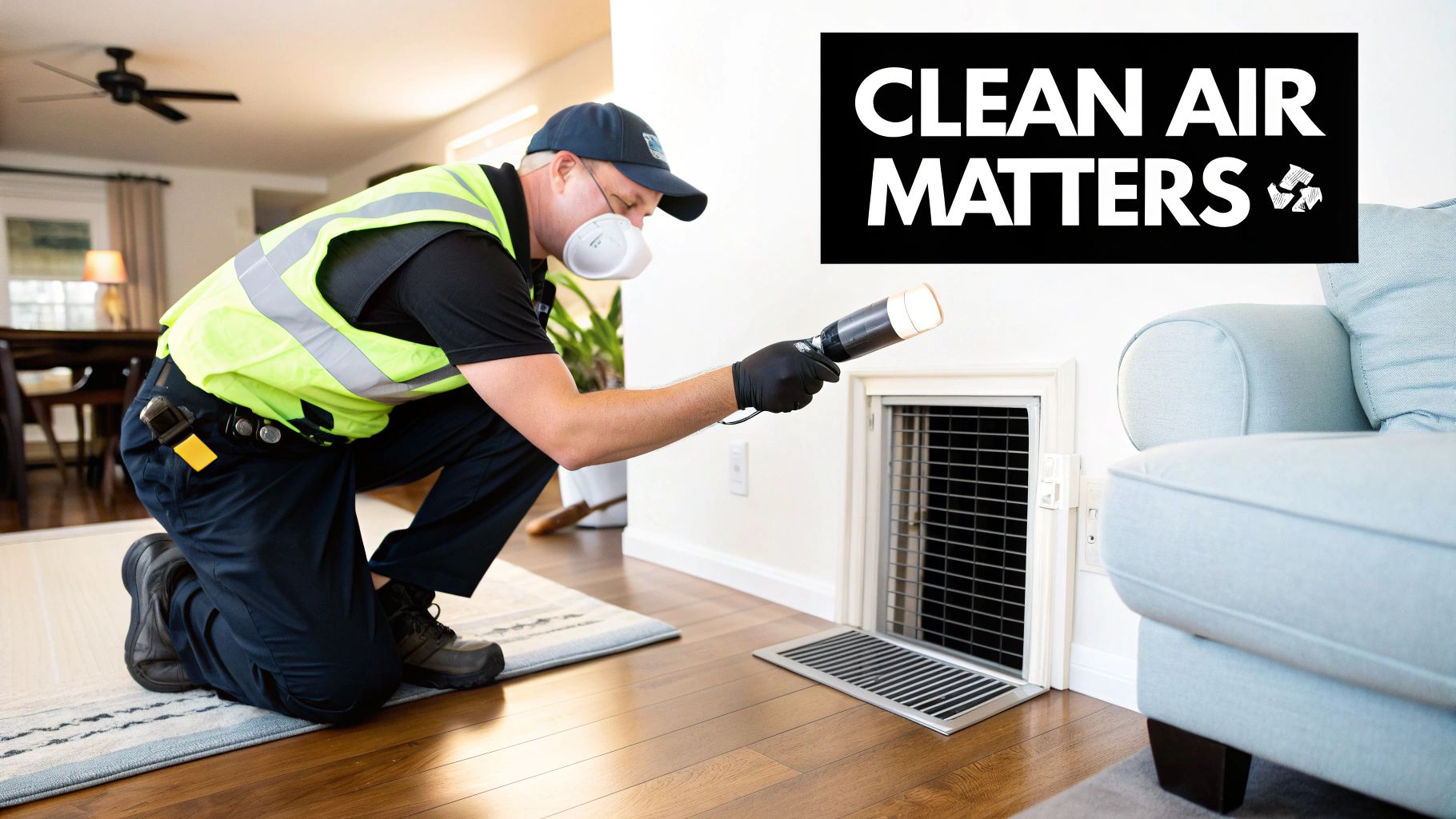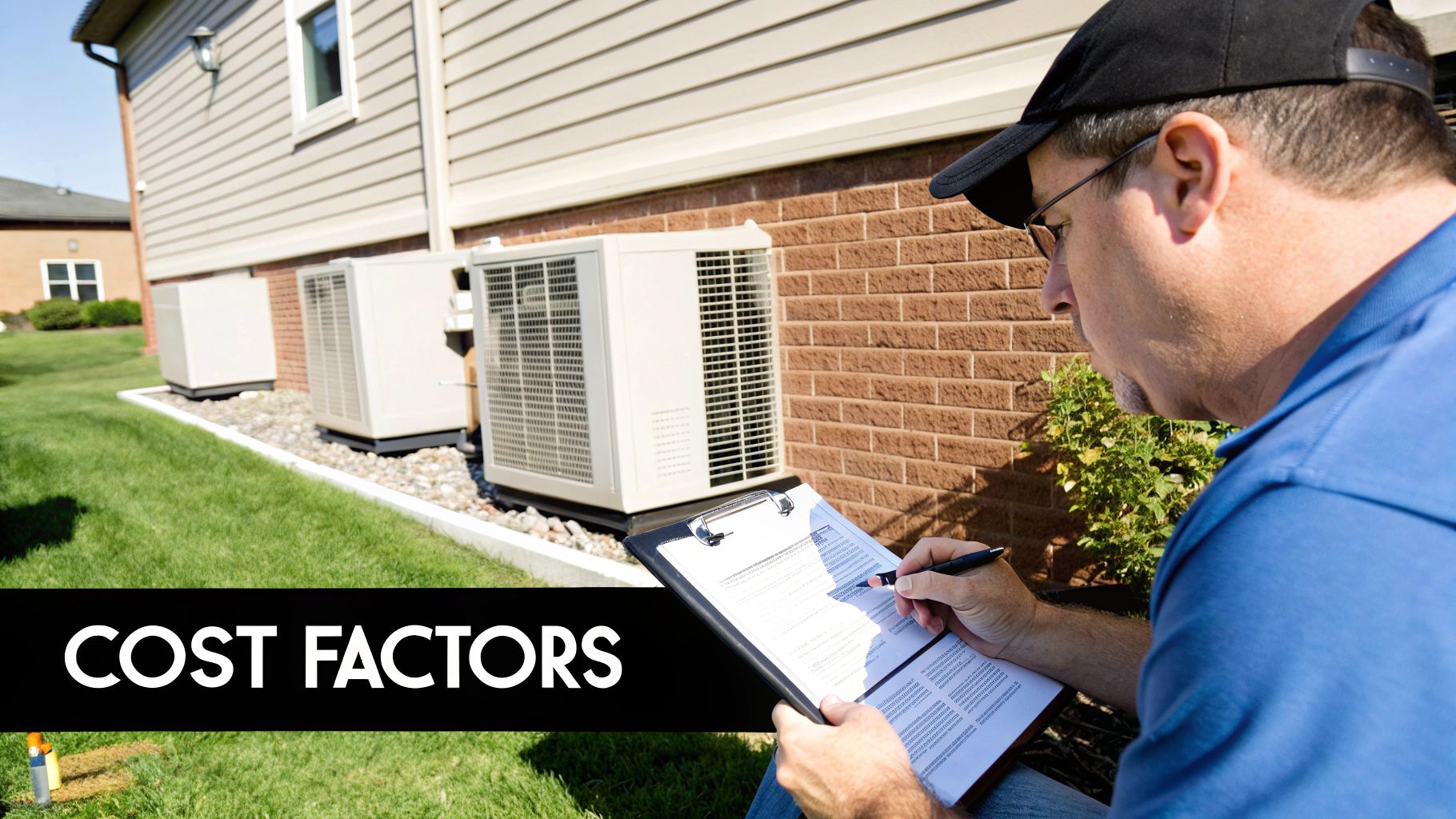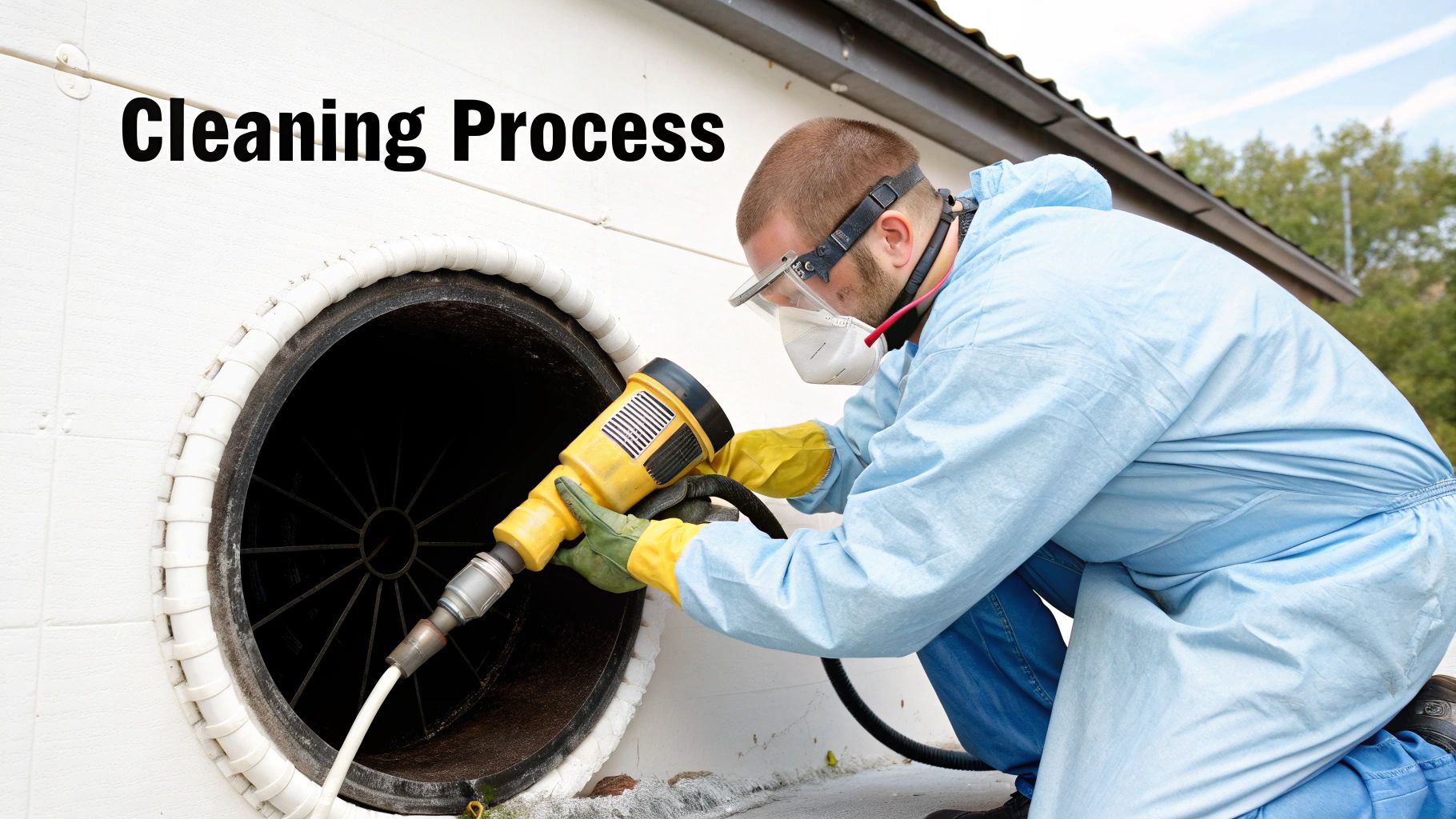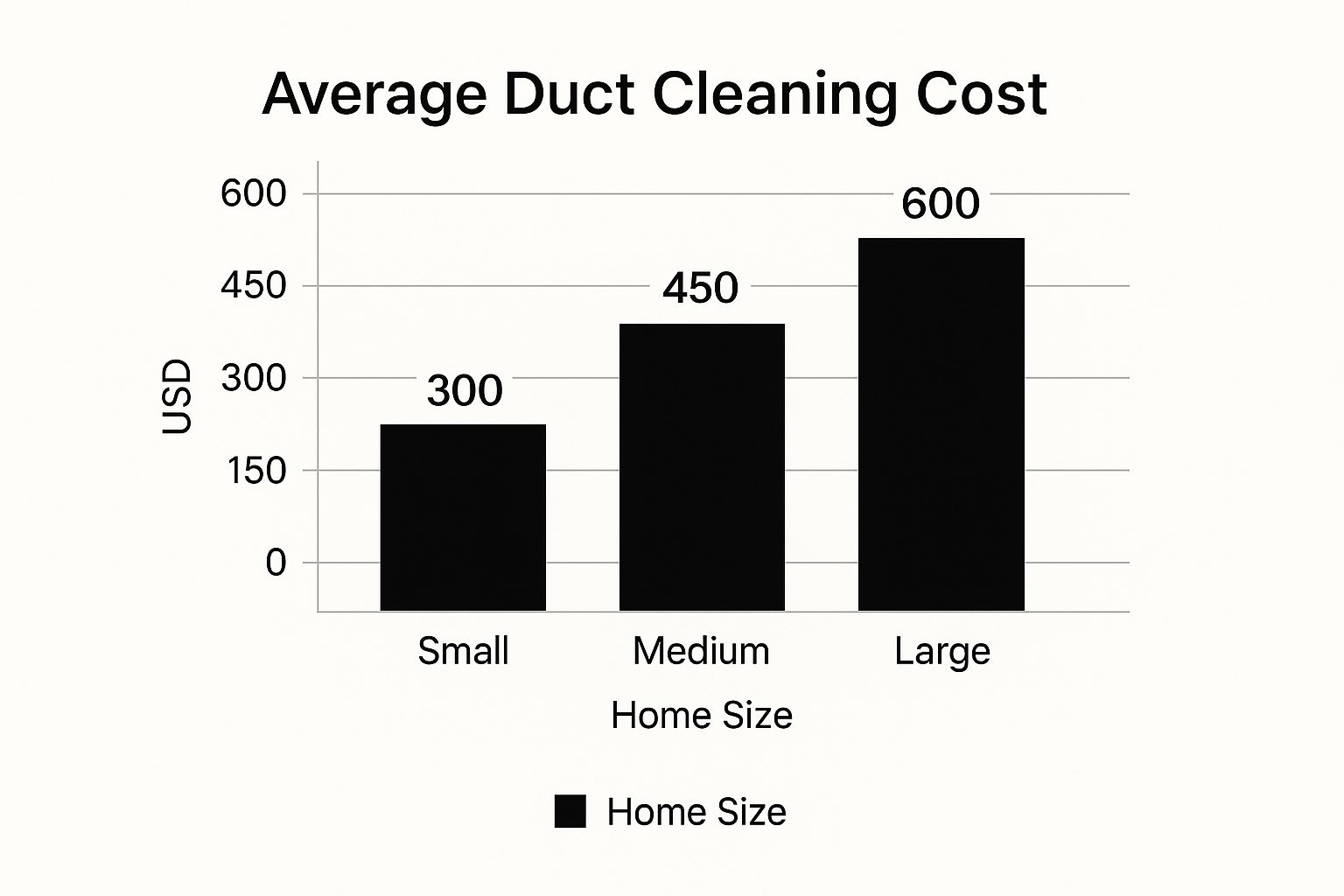So, you're asking, how much for duct cleaning? It’s the first question on every homeowner's mind, and the straightforward answer is that most folks in the GTA can budget somewhere between $400 and $800. That's a solid ballpark for a professional service in a typical single-family home.
Breaking Down Average Duct Cleaning Prices

While that price range is a great starting point, the final number on your quote will hinge on a few key details specific to your house. The single biggest factor? The size of your home. It’s simple, really—a larger house has more ductwork to clean, which means more time and labour for the technicians.
To give you a better idea of what to expect, we can break down the typical costs by the square footage of your home. Think of this as a quick reference to see where you might land.
Estimated Duct Cleaning Costs by Home Size
Here's a look at what you can generally expect to pay based on the size of your home in the Greater Toronto Area.
| Home Size (Square Feet) | Average Cost Range |
|---|---|
| Up to 1,500 sq. ft. | $350 – $500 |
| 1,500 – 2,500 sq. ft. | $450 – $650 |
| 2,500 – 3,500 sq. ft. | $550 – $800+ |
This table gives you a solid estimate to work with, but remember that square footage is just one piece of the puzzle.
The number of vents in your home is another big one. A sprawling bungalow with 25 vents will naturally cost more to service than a two-storey home of the same size with only 15. The layout and complexity of your HVAC system can also nudge the price up or down.
Key Takeaway: Your home’s size and the total number of vents are the two main drivers of your final duct cleaning cost. Use them to get a rough idea, and you’ll be well-prepared when you start getting quotes.
Having these figures in your back pocket helps set realistic expectations before you even pick up the phone. If you want to get a complete picture of what a professional cleaning involves from start to finish, you can learn more from our complete guide to air duct cleaning. It'll get you ready for the next part of our discussion, where we'll explore the other factors that can fine-tune your quote.
The Core Factors That Shape Your Final Bill

While having an average price in mind is a good start, the unique details of your home are what really nail down the final cost. When you're asking "how much for duct cleaning," understanding these factors helps explain why one quote might look completely different from another. The two biggest things that move the needle are your home's size and the complexity of your HVAC system.
Think about it this way: cleaning the ductwork in a cozy single-storey bungalow is a totally different job than servicing a sprawling multi-level home with two separate furnaces. A bigger house doesn't just mean more square footage—it means a more extensive network of ducts snaking through floors and walls. That takes more time, more labour, and more specialized gear to clean from top to bottom.
Home Size and System Layout
The sheer length and layout of your ductwork directly drive the cost. A technician has to access, clean, and seal every single part of that system. So, a more complicated or spread-out layout is naturally going to increase the scope of the job. This is exactly why there’s no such thing as a one-size-fits-all quote.
Beyond just the size, the number of individual HVAC systems is a huge factor. If your home has separate heating and cooling units for different floors, you’ve essentially got two distinct systems to clean. This nearly doubles the work on critical components and, you guessed it, pushes the price up.
Key Insight: At the end of the day, the price is a direct reflection of the work involved. More ductwork, multiple HVAC units, and tricky-to-reach spots all add to the time and effort needed for a thorough, professional cleaning.
Ductwork Material and Accessibility
The material your ducts are made from also plays a part in the cleaning process and its cost. Most Canadian homes have one of two main types:
- Rigid Metal Ducts: Usually made of galvanized steel or aluminum, these ducts are tough and fairly straightforward to clean with standard high-powered vacuums and brushes.
- Flexible Ducts: Often found in newer builds or squeezed into tight spaces, these are made of a wire coil wrapped in plastic. They need a much more delicate touch and special, softer tools to avoid causing tears, which can bump up the labour cost.
On a similar note, accessibility is everything. Ducts crammed into a tight attic or a damp crawlspace are a lot harder to work on than those in an open, unfinished basement. If technicians have to navigate awkward spaces, the job is going to take longer and cost more. Recognizing the warning signs you need duct cleaning early can help you budget for these kinds of factors.
These variables are pretty consistent across North America. For instance, data from the U.S. shows that homeowners typically pay between $450 and $1,000 for professional service, with the price tag scaling based on home size, system complexity, and the total number of vents. A 2,500-square-foot home might land anywhere between $375 and $1,000, which just shows how much things like flexible ductwork or multiple systems can influence the final bill.
Decoding Per-Vent Pricing Models

If you’ve ever called a duct cleaning company for a quote, you've probably heard them talk about a "per-vent" price. It's one of the most common ways professionals estimate a job, and once you get the hang of it, you can figure out a pretty accurate budget before you even pick up the phone.
The logic is straightforward: the total price is based on the number of vents in your home. Instead of a one-size-fits-all flat rate that might overcharge a small bungalow, you pay for exactly what you have. More vents equal more work, and the price scales accordingly. It’s a transparent approach that makes a lot of sense.
Supply Vents vs. Return Vents
Now, here’s where it gets a little more specific. Not all vents are created equal. Your HVAC system uses two different types, and they have different jobs—and different cleaning prices.
- Supply Vents: These are the vents blowing conditioned air into your rooms. You’ll find a lot of them, and they’re usually smaller. Because of this, they're typically cheaper to clean per unit.
- Return Vents: These are the bigger grilles that suck air back into your HVAC system to be heated or cooled again. They're the front line for collecting dust, pet dander, and other debris, which means they're a lot more work to clean properly.
Since return vents are larger and tend to be much dirtier, technicians will almost always charge more for them. Keep that in mind when you’re doing a headcount of your vents.
Pro Tip: Before you call for quotes, do a quick walkthrough of your house and count every single supply and return vent. That one number is the key to getting a solid estimate with a per-vent model.
A Real-World Calculation
Let’s put this into practice. A typical suburban home might have 12 supply vents and 3 larger return vents. A company’s quote might break down like this:
- 12 Supply Vents @ $30 each = $360
- 3 Return Vents @ $50 each = $150
- Total Estimated Cost = $510
This itemized breakdown shows you exactly what you're paying for. These numbers are pretty typical, too. Industry averages show supply vents can range from $25 to $50, while the more labour-intensive return vents often fall between $40 and $75 each.
For an average home with 12 to 16 vents, you can expect the total cost to land somewhere between $300 and $800, depending on your system's complexity and local labour rates.
Knowing the difference between your vents is the first step to understanding any quote you receive. For a deeper dive, check out our guide on professional air vents cleaning. A little bit of knowledge goes a long way in making sure you get a fair price for the work.
Beyond the Basics: Add-Ons and Potential Hidden Costs
That first quote you get for a duct cleaning job is a great starting point, but it's rarely the final number. To get a real handle on the total cost, you need to look past the base price and understand the valuable add-ons—and potential surprises—that can come up.
These extras aren't about upselling you. They’re about tackling specific issues within your HVAC system to do a much more thorough job. Think of it like washing your car: you can just clean the outside, or you can add an interior vacuum and wax for that brand-new feel. It’s the same idea here.
The infographic below gives you a solid idea of baseline duct cleaning costs based on your home's size. Any extra services you choose will build on these numbers.

As you can see, the starting price scales with square footage. Now, let's talk about the services that take your cleaning to the next level.
Common Duct Cleaning Add-Ons and Their Purpose
To help you decide what’s worth it for your home, we’ve put together a quick table outlining the most common add-on services, what they do, and what you can expect them to cost.
| Additional Service | Purpose and Benefit | Average Additional Cost |
|---|---|---|
| Furnace & Blower Motor Cleaning | Removes grime from the system's core components. This prevents dirt from being blown back into clean ducts and improves efficiency. | $150 – $300 |
| A/C Coil Sanitation | Disinfects the evaporator coil, a prime spot for mould and bacteria growth. This improves cooling and stops contaminants from circulating. | $100 – $250 |
| Antimicrobial Sanitizer Fogging | Mists an EPA-approved sanitizer through the entire system after cleaning to kill lingering mould spores, viruses, and bacteria. | $75 – $200 |
| Dryer Vent Cleaning | Clears lint buildup from your dryer vent line, a common fire hazard. This improves dryer efficiency and home safety. | $125 – $250 |
These services turn a standard cleaning into a complete system overhaul, ensuring the air circulating through your home is as clean and healthy as possible.
When Unexpected Issues Drive Up the Cost
Sometimes, during a routine cleaning, technicians uncover bigger problems hiding in the ductwork. When this happens, a standard service just won’t cut it, and the cost will naturally increase to address the issue properly.
The most common culprits are mould growth and pest infestations. If the crew finds mould, they can't just blow it out. It requires a full remediation process with specialized equipment and solutions to kill the growth and prevent it from returning. This can easily add $700 to $2,000 to the final bill.
It's a similar story with pests. Discovering rodent droppings or insect nests means the entire system needs a deep, sanitizing clean to make it safe again. Another surprise could be leaky ductwork, which kills your system's efficiency. Learning about the benefits of applying a mastic sealant for your ductwork can show you why this is a crucial fix.
While these discoveries are never welcome, tackling them head-on is essential for the health and safety of your home.
How Your Location and Duct Condition Affect Your Quote
The size of your home isn't the only thing that moves the needle on your duct cleaning quote. Two other huge factors are where you live in the GTA and the actual state of your ductwork. Professionals look at these closely when figuring out the final price.
It's true for most services, and duct cleaning is no exception: location matters. A company’s day-to-day operating costs—think fuel, insurance, and local labour rates—can vary quite a bit between downtown Toronto and the surrounding suburbs like Mississauga or Vaughan. Those logistical realities often mean a quote for a home in a congested urban core might be a bit higher than for one in a less busy area.
The Age and Material of Your Ductwork
Beyond your postal code, the condition of your ducts themselves plays a massive role. The material they're made from determines the tools and techniques needed for a safe, effective cleaning, which directly impacts the time and effort involved.
You'll typically find two main types in GTA homes:
- Metal Ducts: These rigid ducts are common in older homes. They’re built to last and are usually pretty straightforward to clean, allowing technicians to use powerful brushes and high-suction vacuums without much worry.
- Flexible Ducts: Often used in newer homes or for additions, these "flex" ducts are far more delicate. They need a gentle touch with specialized, softer tools to avoid rips and tears, which naturally means more time and a higher labour cost.
The state of your ductwork tells a story about your home's history. An older, simpler system might be easier to clean, but a newer one with fragile materials requires a specialist's care—and that will be reflected in the cost.
The physical shape your ducts are in is just as critical as what they're made of. A well-maintained system will always cost less to clean than one that’s clearly damaged, has leaky seals, or just looks neglected. Cleaning is one thing, but understanding the overall health of your HVAC system is just as crucial. For example, learning about HVAC duct sizing and its importance shows how well-designed ductwork contributes to both efficiency and cleanliness.
These principles hold true everywhere, but local trends really highlight them. In high-demand areas, for instance, homes with flexible ducts almost always cost more to service because of the extra care and time needed. It all comes down to the local housing stock and the type of ductwork contractors are most likely to run into day after day.
How to Get an Accurate Quote and Avoid Scams
Knowing what goes into a proper duct cleaning quote is your best line of defence. It’s not just about protecting your wallet; it’s about making sure you get quality work and can confidently answer "how much for duct cleaning?" for your specific home.
It all starts with asking the right questions. Any reputable pro will be happy to give you clear, detailed answers. Before you agree to anything, insist on getting a comprehensive, itemized quote in writing. This document needs to break down every single charge so there are absolutely no surprise fees down the road.
Key Questions for Your Potential Contractor
Think of this as your quick checklist when you’re on the phone with a potential company. How they answer will tell you a lot about their professionalism and whether they’re being transparent.
- Can you show me proof of your business liability insurance?
- Do you follow the cleaning standards set by the National Air Duct Cleaners Association (NADCA)?
- Will I get a detailed, written quote before you start any work?
- What kind of cleaning methods and equipment do you actually use?
- Does your price include cleaning the furnace blower and A/C coils, or are those extra charges?
Beyond the initial quote, a company's professionalism often shows in how they handle their business operations. You can get a sense of what professional standards look like by checking out this guide to simplified invoicing and payment processes.
Spotting Common Red Flags
Unfortunately, this industry has its share of shady operators. The biggest red flag is the unbelievably cheap "whole-house special," often dangled for $99 or less. This isn't a real price; it’s a classic bait-and-switch to get their foot in your door.
Warning: Be extremely skeptical of any quote that seems too good to be true. These deals almost always lead to aggressive upselling, high-pressure tactics for services you don’t need, and shoddy work that can even damage your ductwork.
Think about it: a legitimate company invests in powerful, truck-mounted equipment, carries proper insurance, and pays for trained technicians. It's simply impossible to do a thorough, professional job for those rock-bottom prices. To keep yourself safe, get familiar with the tactics these companies use. You can dig deeper in our guide on how to spot and avoid common duct cleaning scams. Knowing what to look for is the best way to make sure you get a fair price for a job done right.
Frequently Asked Questions About Duct Cleaning
Alright, let's tackle some of the most common questions we get from homeowners. We know you’ve got them, and getting straight answers is the best way to feel good about your decision.
How Often Should I Get My Air Ducts Cleaned?
The rule of thumb we usually tell people is every 3 to 5 years. But honestly, that’s just a guideline—every home is different.
You’ll want to think about getting them cleaned more often if you:
- Have furry friends leaving dander and hair everywhere.
- Live with anyone who suffers from allergies or asthma.
- Just finished a big renovation project (that dust gets everywhere!).
- Feel like you're constantly dusting, even right after you've cleaned.
And here’s the most obvious clue: if you can peek into your vents and see a bunch of gunk and dust, it's definitely time to give a professional a call.
How Long Does a Professional Duct Cleaning Take?
For a typical home around 2,000 square feet, a proper, thorough duct cleaning is going to take somewhere between 3 to 5 hours. The final time depends on how big your house is, how complex the ductwork is, and whether you’ve added other services, like a furnace cleaning.
A word of caution: if a company promises they can be in and out in an hour, you should be skeptical. That’s a huge red flag for a cheap, superficial job that won’t really clean your system—and it might even be a scam.
Will Duct Cleaning Lower My Energy Bills?
While the biggest win from duct cleaning is better air quality inside your home, it can absolutely help your HVAC system run more efficiently. Think about it: when your ducts are clogged up with dust and debris, your system has to fight to push air through. That extra effort uses more energy.
By clearing out all those blockages, you’re letting your system breathe easier. It doesn't have to work as hard, which can lead to some nice little savings on your heating and cooling bills. Over time, that efficiency boost can help the service pay for itself.
Ready to breathe cleaner air and give your HVAC system a break? The team at Can Do Duct Cleaning has been providing top-notch service across the GTA for over 30 years. Get your free, no-obligation quote today!


